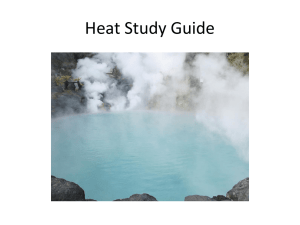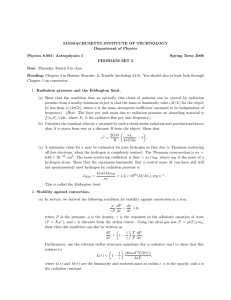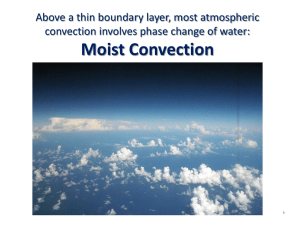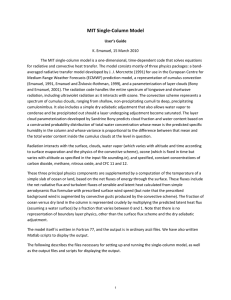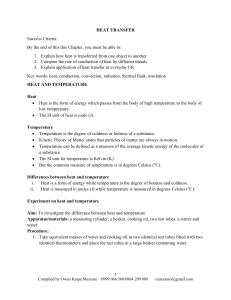Physics: Energy Whole unit overview www.XtremePapers.com
advertisement
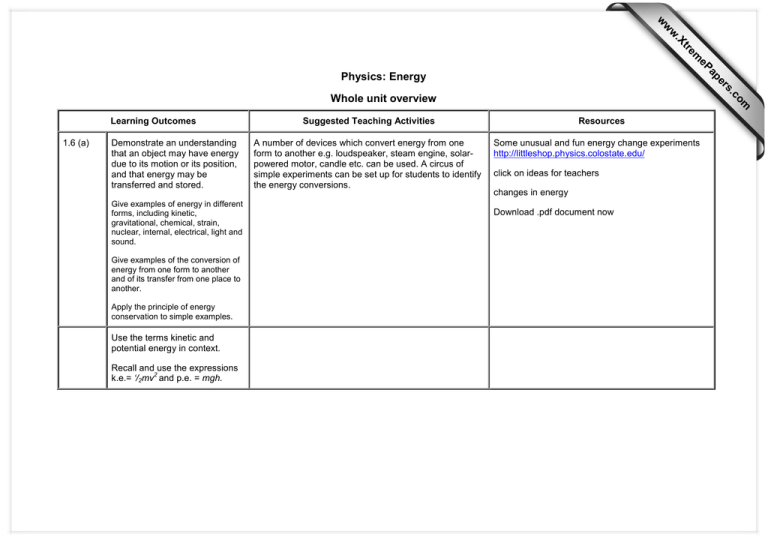
s er ap eP m e tr .X w w w Physics: Energy om .c Whole unit overview Learning Outcomes 1.6 (a) Demonstrate an understanding that an object may have energy due to its motion or its position, and that energy may be transferred and stored. Give examples of energy in different forms, including kinetic, gravitational, chemical, strain, nuclear, internal, electrical, light and sound. Give examples of the conversion of energy from one form to another and of its transfer from one place to another. Apply the principle of energy conservation to simple examples. Use the terms kinetic and potential energy in context. Recall and use the expressions 2 k.e.= ‘/2mv and p.e. = mgh. Suggested Teaching Activities A number of devices which convert energy from one form to another e.g. loudspeaker, steam engine, solarpowered motor, candle etc. can be used. A circus of simple experiments can be set up for students to identify the energy conversions. Resources Some unusual and fun energy change experiments http://littleshop.physics.colostate.edu/ click on ideas for teachers changes in energy Download .pdf document now 1.6 (b) Describe how electricity or other useful forms of energy may be obtained from Important discussions here to consolidate the students’ understanding of energy processes both in physical and environmental impact terms. (i) chemical energy stored in fuel (ii) water, including the energy stored in waves, in tides and in water behind hydroelectric dams This site gives much interesting information about different types of power stations and includes a virtual tour of a power station. http://www.ergon.com.au/ (iii) geothermal resources Click on EnergyEd, EnergyEd (iv) nuclear fission An excellent site. (v) heat and light from the Sun. Show an understanding that energy is released by nuclear fusion in the Sun Show a qualitative understanding of efficiency. 2.3 (a) 2.3 (b) This site provides a useful investigation into alternative energy. http://ericir.syr.edu/ Click on ‘Lesson Plans’, physical sciences, Solar Hot Box. Describe experiments to demonstrate the properties of good and bad conductors of heat. Simple experiments to compare thermal conductivity e.g. using metal conductivity rods. Give a simple molecular account of the heat transfer in solids. Extend to a molecular account – a row of students can be used to model the idea of increased vibration of particles as the process of conduction. Relate convection in fluids to density changes and describe experiments to illustrate convection. Use simple experiments to illustrate convection e.g. dissolving a crystal of potassium manganate VII at the bottom of a large beaker that is heated by a candle flame. Show convection in air using, for example, a mine ventilation model. 2.3 (c) Identify infra-red radiation as part of the electromagnetic spectrum. Describe experiments to show the properties of good and bad emitters and good and bad absorbers of infra-red radiation. Leslie’s cube type experiments show the effect of the colour of a surface on the emission of radiation. A thick (3 – 5 mm) sheet of copper, covered with lamp-black (powdered carbon) on one side, if heated strongly with a Bunsen Burner on the other side, will emit noticeably more heat from the blackened side when the Bunsen burner is removed. Absorption of infra-red can be easily shown by arranging two thermometers at equal distances from a working 12V headlamp bulb. One thermometer has a blackened bulb (use a felt-tipped pen or poster paint) 2.3 (d) Identify and explain some of the everyday applications and consequences of conduction, convection and radiation. A good opportunity to carry out some investigative experiments involving rate of cooling and insulation. Discussion of the vacuum flask is a useful way to revise conduction, convection and radiation as is discussion of the domestic refrigerator.
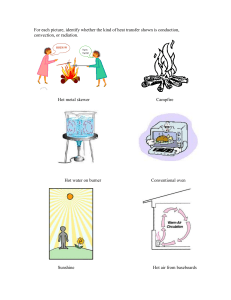

![Applied Heat Transfer [Opens in New Window]](http://s3.studylib.net/store/data/008526779_1-b12564ed87263f3384d65f395321d919-300x300.png)
